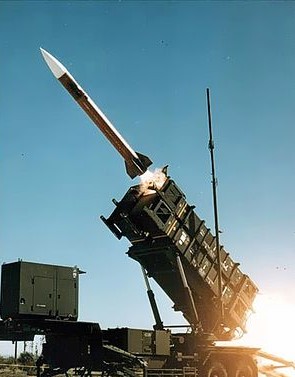
Patriot Guided Missile
Wikipedia | 2013-12-04 21:08
| Patriot missile | |
 Four Patriot missiles can be fired from the highly mobile TEL |
|
| Type | Surface-to-air missile |
| Place of origin | United States |
| Production history | |
| Designer | Raytheon |
| Unit cost | US$ 1 to 6 million |
| Number built | over 8,600 |
| Variants | Standard, ASOJ/SOJC, PAC-2, PAC-2 GEM, GEM/C, GEM/T (or GEM+) and PAC-3 |
| Specifications (PAC-1[1]) | |
| Weight | 700 kg (1,500 lb) |
| Length | 5,800 mm (19 ft 0 in) |
| Diameter | 410 mm (16 in) |
|
|
|
| Warhead | M248 Composition B HE blast/fragmentation with two layers of pre-formed fragments and Octol 75/25 HE blast/fragmentation |
| Warhead weight | 200 lb (90 kg) |
|
Detonation mechanism |
Proximity fuze |
|
|
|
| Wingspan | 920 mm (3 ft 0 in) |
| Propellant | Solid-fuel rocket |
|
Operational range |
PAC - 1 :70 km PAC - 2 :160 km PAC - 3 :20 km against ballistic missile and 160 km against aircraft |
| Flight altitude | 79,500 feet (24,200 m) |
| Speed | Mach 5.0 |
|
Guidance system |
Radio command with Track Via Missile semi-active homing |
|
Launch platform |
mobile trainable four-round semi-trailer |
The first fielded variant was the round MIM-104A, "Standard." It was optimized solely for engagements against aircraft and had very limited capability against ballistic missiles. It had a range of 70 km (43 mi), and a speed in excess of Mach 3. The MIM-104B "anti-standoff jammer" (ASOJ) is a missile designed to seek out and destroy ECM emitters.
The MIM-104C PAC-2 missile was the first Patriot missile that was optimized for ballistic missile engagements. The GEM series of missiles (MIM-104D/E) are further refinements of the PAC-2 missile. The PAC-3 missile is a new interceptor, featuring a Ka band active radar seeker, employing "hit-to-kill" interception (in contrast to previous interceptors' method of exploding in the vicinity of the target, destroying it with shrapnel), and several other enhancements which dramatically increase its lethality against ballistic missiles. It has a substantially lower range of 15 km. The specific information for these different kinds of missiles are discussed in the "Upgrades" section.
The first seven of these are in the larger PAC-2 configuration of a single missile per canister, of which four can be placed on a launcher. PAC-3 missile canisters contain four missiles, so that sixteen rounds can be placed on a launcher. The missile canister serves as both the shipping and storage container and the launch tube. Patriot missiles are referred to as "certified rounds" as they leave the factory, and additional maintenance is not necessary on the missile prior to it being launched.
The PAC-2 missile is 5.8 metres (19 ft 0 in) long, weighs about 900 kilograms (2,000 lb), and is propelled by a solid-fueled rocket motor at speeds in excess of Mach 5.0.
Patriot missile design
The PAC-2 family of missiles all have a fairly standard design, the only differences between the variants being certain internal components. They consist of (from front to rear) the radome, guidance section, warhead section, propulsion section, and control actuator section.
The radome is made of slip-cast fused silica approximately 16.5 millimetres (0.65 in) thick, with nickel alloy tip, and a composite base attachment ring bonded to the slip cast fused silica and protected by a molded silicone rubber ring. The radome provides an aerodynamic shape for the missile and microwave window and thermal protection for the RF seeker and electronic components.
The Patriot guidance section consists primarily of the modular digital airborne guidance system (MDAGS). The MDAGS consists of a modular midcourse package that performs all of the required guidance functions from launch through midcourse and a terminal guidance section. The TVM seeker is mounted on the guidance section, extending into the radome. The seeker consists of an antenna mounted on an inertial platform, antenna control electronics, a receiver, and a transmitter. The Modular Midcourse Package (MMP), which is located in the forward portion of the warhead section, consists of the navigational electronics and a missile-borne computer that computes the guidance and autopilot algorithms and provides steering commands according to a resident computer program.
The warhead section, just aft of the guidance section, contains the proximity fused warhead, safety-and-arming device, fuzing circuits and antennas, link antenna switching circuits, auxiliary electronics, inertial sensor assembly, and signal data converter.
The propulsion section consists of the rocket motor, external heat shield, and two external conduits. The rocket motor includes the case, nozzle assembly, propellant, liner and insulation, pyrogen igniter, and propulsion arming and firing unit. The casing of the motor is an integral structural element of the missile airframe. It contains a conventional, casebonded solid rocket propellant.
The Control Actuator Section (CAS) is at the aft end of the missile. It receives commands from the missile autopilot and positions the fins. The missile fins steer and stabilize the missile in flight. A fin servo system positions the fins. The fin servo system consists of hydraulic actuators and valves and an electrohydraulic power supply. The electrohydraulic power consists of battery, motor pump, oil reservoir, gas pressure bottle, and accumulator.
Share this page



















